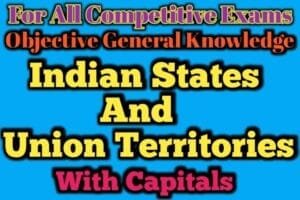For all competitive exams, Geography Objective General Knowledge Questions answers are the most important. So here we have tried to present some most important “Objective General Knowledge” questions and answers on Geography that have already been selected in various competitive exams in our country.
- What is the term used to describe cultivation on Hill slopes with small patches of land in descending order ? A) truck farming
B) slope cultivation
C) Hill farming
D) contour farming
ANSWER= (D) contour farming
- What is “Jhoom”? A) A type of cultivation
B) a type of swinging basket
C) a River Valley in a dry region
D) a tribal dance of MP
ANSWER= (A) A type of cultivation
- Which crop requires water-logging for its cultivation ? A) Tea
B) coffee
C) rice region
D) mustard
ANSWER= (A) rice
- It rain falls only for two months, the crop best suited to the resulting conditions will be – A) Rice
B) sugar cane
C) tea
D) pulses
ANSWER= (A) pulses
- How can the yield of maize be increased ? A) By evolving high yielding varieties 2 different areas of the country
B) by providing more irrigation facilities
C) by growing major simultaneously with legume crops
D) by all these methods
ANSWER= (A) By evolving high yielding varieties 2 different areas of the country
- Which statement is true ? A Tea each cultivated at higher elevations than coffee
B) De grown at lower elevations that coffee
C) elevation is not very important, it is the factor offset that is important in the case of coffee
D) none of these statements is true
ANSWER= (A) elevation is not very important, it is the factor offset that is important in the case of coffee - In an area with annual rainfall of more than 200 centimetre and sloping Hills, which crop will be ideal? A Jute
B) cotton
C) maize
D) tea
ANSWER= (D) tea - Which state is the leading producer of coconut ? Assam
B) Kerala
C) Tamil Nadu
D) Karnataka
ANSWER= (B) Kerala - Sugar cane in India matures in about – 5 months
B) 3 months
C) 7 months
D) 12 months
ANSWER= (C) 7 months
41.Through which state does the river Chambal floor?
UP,MP, Rajasthan.
B) MP, Gujarat, UP
C) Rajasthan, MP, Bihar.
D) Gujarat, MP, Chhattisgarh.
ANSWER= (A) UP,MP, Rajasthan
- One river flowing towards the west is the A) Godavari. .
B) Kaveri
C) Narmada.
D) Krishna.
ANSWER= (C) Narmada - Most rivers flowing West from the Western Ghats do not form deltas because of A) lack of eroded material. .
B) the high gradient
C) lack of vegetation free area.
D) low velocity label>
ANSWER= (B) the high gradient - The Thar desert is believed to be expanding. The most suitable way to check it would be by A) afforestation.
B) artificial rain
C) canal irrigation. area.
D) using the area for cattle rearing
ANSWER= (A) afforestation - Which one is a land- locked state? A) Gujarat.
B) Andhra Pradesh
C) West Bengal. area.
D) Bihar
ANSWER= (D) Bihar - Which area in India gets the summer monsoon first? A) the Himalayas.
B) the eastern ghats
C) the Western ghats. area.
D) the indo-gangetic plains.
ANSWER= (D) the Western ghats - In which of the following areas is maximum precipitation received from the summer monsoon? A) the Coromandel coast.
B) the North eastern hill region
C) the central Indian hills.
D) the Western Himalayas.
ANSWER= (B) the North eastern hill region - Winter rains in North- Western India are caused by A) Westerly depressions. .
B) retreating monsoon
C) trade winds
D) south- westerly monsoons.
ANSWER= (A) Westerly depressions - Which soil swells when wet and develops cracks when dry? A) Alluvial. .
B) red
C) black.
D) laterite..
ANSWER= (C) black - Why are plants grown along river banks? A) To prevent floods.
B) to provide shade
C) To reduce silting and erosion.
D) to control pollution.
ANSWER= (B) To reduce silting and erosion.
31.What kind of soil is treated with gypsum to make it suitable for cropping?
A) alkaline. .
B) acidic
C) waterlogged.
D soil with excess clay content.
ANSWER= (A) alkaline
30.The rate of rotation of the earth on its axis is highest
A) January 3 . .
B) January 10
C) July 4 .
D) it never changes .content.
ANSWER= (D) it never changes .
29.What is the international dateline ?
A) It is the equator. .
B) it is the 10 degree longitude
C) it is the 90 degree East longitude.
D) it is the 180 degree longitude.
ANSWER= (D) it is the 180 degree longitude
- One astronomical unit is the average distance between A) Earth and the sun.
B) earth and the moon longitude
C) Jupiter and the sun
D) Pluto and the sun
ANSWER= (A) Earth and the sun.
27.What is the unit measurement of the distances of stars from the earth ?
A) Light year
B) Fathoms longitude
C) Nautical miles
D) Kilometers
ANSWER= (A) Light year
26.On the surface of the moon ,the
A) Mass and weight become lesser
B) mass remains constant and only the weight laser
C) only the match is lesser
D) mass and weight both remain unchanged
ANSWER= (B) mass remains constant and only the weight laser
25.Light from the nearest star reaches the earth in
A) 4.3 seconds
B) 4.3 minutes
C) 43 minutes
D) 4.3 years
ANSWER= (D) 4.3 years
- Which comet appears every 76 years ? A) Hailey’s
B) Alpha Centauri
C) Donati’s
D) Holme’s
ANSWER= (A) Hailey’s
23.We always see the same face of the moon because
A) it is smaller than the earth
B) it revolves on its axis in a direction opposite to that of the earth
C) it takes equal time for both revolution around the earth and rotation on its own axis
D) it rotates at the same speed as the earth around the sun
ANSWER= (C) it takes equal time for both revolution around the earth and rotation on its own axis
22.Which of the following will never get the vertical raise of the sun?
A) Shrinagaar
B) Mumbai
C) Thiruvananthapuram
D) Chennai
ANSWER= (A) Shrinagaar
Identify the sedimentary rocks. i) Basalt ii) Limestone iii) Shala iv) Granite v) Quartzite A) a) i and ii
B) ii and iii
C) ii and v
D) iii and v
ANSWER= (B) ii and iii
Name the instrument used for measuring humidity . A) a) barometer
B) thermometer
C) hygrometer
D) hydrometer
ANSWER= (C) hygrometer
The water content in the atmosphere A) is not dependent on temperature
B) increases as temperature increases
C) remains unchanged with change in temperature
D) cannot be measured
ANSWER= (B) increases as temperature increases
What will happen if the temperature of water is lowered from 8 degree Celsius to 3 degrees Celsius ? A) Water are will freeze temperature
B) water will not change in volume
C) the volume will first increase then decrease temperature
D) the volume will first decrease then increase
ANSWER= (B) water will not change in volume
Which is the shortest route from Moscow to San Francisco ? A) via Canada
B) over land volume
C) over the South Pole
D) over the North Pole
ANSWER= (D) over the North Pole
What is the importance of ozone in the atmosphere ? A) It provides protection against ultraviolet radiation
B) it provides condensation nuclei
C) It creates the greenhouse effect on earth
D) it helps scatter blue light
ANSWER= (A) It provides protection against ultraviolet radiation
Assertion(A) : Eclipses do not occur on all full moon new moon days . Reason(R) :The moon revolves around the earth in an Elliptical orbit A) A and R are true and R correctly explains A radiation
B) A and R are true but R does not explain A
C) A is true but R is false
D) R is true but A is false
ANSWER= (B) A and R are true but R does not explain A
Which river flows between the Satpuras and the Vindhyas? A) Godavari. .
B) Gandak
C) Tapti. . .
D) Narmada
ANSWER= (D) Narmada
The rate of erosion in a stream is the highest where? A) Depth is greater
B) breadth is greater
C) velocity is more
D) the River joins the sea
ANSWER= (C) velocity is more
Isohels are the Isopleths of A) Sunshine
B) flowering time
C) rain
D) clouds
ANSWER= (A) Sunshine
Metamorphic rocks originated from A) Igneous rocks
B) sedimentary rocks
C) both igneous and sedimentary rocks
D) both igneous and sedimentary rocks
ANSWER= (C) both igneous and sedimentary rocks
The best way to define Rock types will be A) igneous-carbonate-metamorphic.
B) sedimentary- igneous -limestone
C) igneous- sedimentary- metamorphic.
D) igneous -metamorphic- marble
ANSWER= (C) igneous- sedimentary- metamorphic.
As one moves from the equator to the poles along a meridian A) the variety of plants and animals increase.
B) the variety of plants and animals decrease
C) the variety of plants increases and of animals decreases.
D) the variety of animals increases and of plants decreases.
ANSWER= (B) the variety of plants and animals decrease
Which one of the alternatives is /are correctly matched? I) Eskimo-Canada. II) Oran – Norway III) Lapps- India. IV) Gonds- Africa A) I and II.
B II and III
C) IV.
D) I
ANSWER= (D) I
Which countries lie on either side of the Radcliffe Line? A) India and Bangladesh.
B) Nepal and India
C) North and South Korea.
D) India and Pakistan
ANSWER= (D) India and Pakistan
Which countries are joined by Palk Strait? A) India and Sri Lanka.
B) North and South Korea
C) Pakistan and China.
D) Britain and France
ANSWER= (A) India and Sri Lanka.
Which country is known as the sugar bowl of the world? A) India. .
B) Cuba
C) Russia.
D) USA
ANSWER= (D) Cuba
In an oil well, what is the ascending order (from bottom) of oil, water and gas? A) water, oil,gas. . .
B) oil,gas,water
C) gas,water,oil.
D) water,gas,oil
ANSWER= (A) water, oil,gas.
Trees shed their leaves in winter season to – A) conserve heat. . . .
B) take rest after the summer
C) conserve water
D) escaped being eaten by animals
ANSWER= (A) conserve heat.
Cotton fibre is obtained from the A) stem. . .
B) root
C) leaf.
D) fruit
ANSWER= (D) fruit.
Duncan pass is located between A) south and little Andaman. .
B) North and South Andaman
C) north and middle Andaman. .
D) Andaman and Nicobar
ANSWER= (D) south and little Andaman.
Which river flows between the Satpuras and the Vindhyas? A) Godavari. .
B) Gandak
C) Tapti. . .
D) Narmada
ANSWER= (D) Narmada







